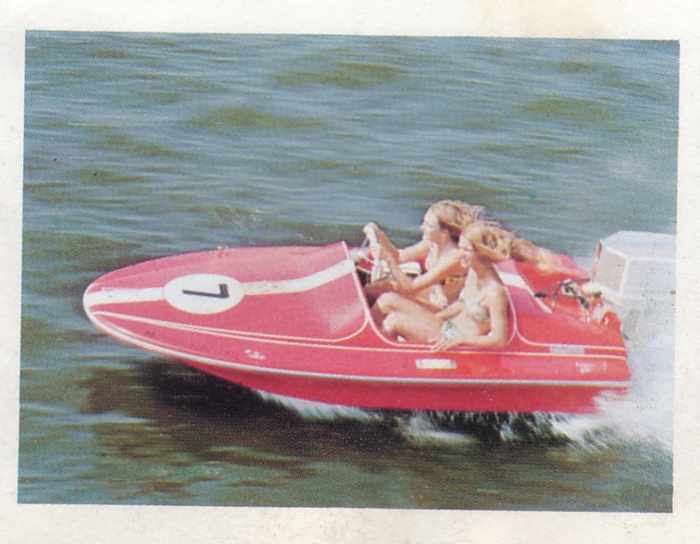HORSEPOWER FOR OUTBOARD BOATS
HORSEPOWER: SPECIAL RULES FOR SMALL OUTBOARD BOATS
How to determine horsepower for small boats under 13 feet using a performance based test course.obtaining one of these boats
I do not know if any manufacturer is
currently producing these types of boats. However, there are a lot of them
still around. On various boating forums I see people asking questions
after obtaining one of theses boats. Some amusement parks use them, inluding Disney World. The questions are usually "What brand is this boat? Who made it?
They are looking for more information, especially on horsepower ratings, safe loading and how many persons they can carry.
I suppose someone will figure out how to use electric outboards or electric inboard jets with this type of boat, so the rules still apply. The best known brands of these boats were Cougar Cub, the disney SeaRaycers, and the GW Invader. The photo is of the GW Invader. (photo is from a brochure found on Fiberglassics at https://www.fiberglassics.com/forum/main-forum.html)
Taken from Title 33 Code of Federal Regulations Subpart 183.53
To use this method of finding horsepower your boat must be:
13 feet or less in length.
Remote wheel steering.
Minimum 19 inch transom height or:
for boats with a motor well height of at least 19 inches, a 15 inch transom height.
Maximum persons capacity of 2 or less.
This is a test course method. (See image below) The boat must be run through a test course successfully. You can rate it for the horsepower at which it was able to maneuver through the test course successfully. The Maximum horsepower cannot exceed 40 horsepower.
For more information call the Coast Guard 202-372-1077 or FAX 202-372-1908, or for a copy of the test course method call the ABYC at 410-990-4460 or fax 410-990-4466.
The Basics:
Test the boat with the engine you wish to rate it for but not more than 40 horsepower.
The boat must be rigged according to the engine manufacturer's specifications.
Install the lowest ratio steering system offered.
Use the manufacturer's recommended propeller.
Portable fuel tanks must be in their designated spot or as far aft as possible.
Mount the engine in it's lowest vertical position on the transom, or at the height recommended by the manufacturer.
All equipment must be new or new condition.
Test Conditions: Smooth calm day. Wind speed below 10 knots
Driver must weigh no more than 200 pounds.
Adjust motor trim angle for maximum full throttle speed, short of porpoising or cavitation.
There are two tests: The Quick Turn test, and the Test Course.
 |
Quick Turn: While powering at a low speed in a straight line, steering 180 degrees in the direction of least resistance, in ½ second or less. Hold it in that position without changing the throttle, trim or wheel position. If the boat completes a 90 degree turn without loss of control or reducing throttle it has successfully completed the test. REPEAT at gradually higher speeds until the boat cannot complete the test or can complete it at maximum throttle.
Test Course method: Run the course at 30 MPH. Pass outside the marker for 35 - 37.5 MPH with out hitting any course markers. If this is successful increase the speed to 35 and run the course again. If this is successful run the course again at 37.5 to 42.5 MPH. Pass outside the marker for that speed. If this is successful, and the throttle was not at full setting, run the course again at full throttle passing outside the maker for 42.5 MPH. The boat passes the test when it successfully completes the course without hitting any markers. If It fails to go through the course without hitting any markers then the lower horsepower rating must be used.
For boats that can do less than 35; the maximum rating is the maximum horsepower at which the boat was able to go through the course at full throttle without hitting anything, and complete the Quick Turn Test; Or you can use the formula for that size boat.
For boats with speed of 35 MPH or greater; The maximum rating is the maximum horsepower at which the boat was able to go through the course without hitting anything, and pass the Quick Turn Test; or you can use the formula for that size boat.
The Maximum horsepower cannot exceed 40 horsepower.
So if you manage to get through this with a 50 horse motor, forget it! You have to use 40. If you make it through with 30, that's it! 30 is the Maximum you can rate the boat for.
Also, the Coast Guard requires that you have the test observed by a qualified person, such as a Professional Engineer, Naval Architect or Law Enforcement Officer, and that they certify in writing that the boat passed the test. OR; you can have a recognized test laboratory do the test and certify the results.
| << Safe Horsepower | Safe Loading>> |
|
This Web site may contain copyrighted material the use of which has not always been specifically authorized by the copyright owner. I am making such material available in my efforts to advance understanding of educational, economic, and scientific issues, etc. I believe this constitutes a "fair use" of any such copyrighted material as provided for in section 107 of the US Copyright Law. In accordance with Title 17 U.S.C. Section 107, the material on this Web site is distributed without profit to those who have expressed a prior interest in receiving the included information for nonprofit educational purposes. For more information see: www.law.cornell.edu/uscode/17/107.shtml. If you wish to use copyrighted material from this Web site for purposes of your own that go beyond "fair use", you must obtain permission from the copyright owner. |
Adverisement


